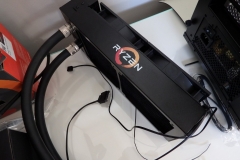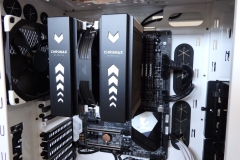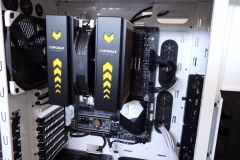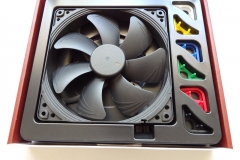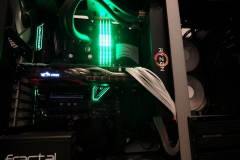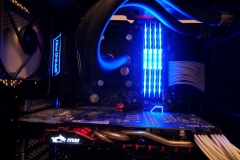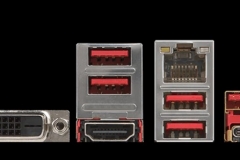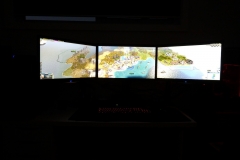This ‘mailbag’ article addresses a number of reader questions that we have received via email and in person about our Ryzen 7 review and test bench.
Ryzen has been an impressive offering from AMD in 2017 and was a much needed viable alternative to Intel’s CPU fleet. From what we have seen, many gamers are now seriously considering the new AMD platform for their next system in a significant change from 12 months ago where Intel platforms dominated the forums when it came to user recommendations and PC Store default builds.
Q. Which AIO is that and where did you get it?
The water cooler is EKWB’s EK-XLC240 Predator. We received this courtesy of AMD in our review kit with our Ryzen 7 1700 review sample.
It can be purchased for around $269 but you may have to look around for it online. Whilst it performs well thermally, we’ll be switching back to air cooling in the near future as the EK XLC240 has an occasional airlock/pump issue that requires us to tap the pump or jiggle the hose to get water flowing. It’s intermittent but an air cooler like the NH-D15 is a much simpler solution with similar performance, less hassle and a lower noise profile.
Q. Are those cables custom made or did you re-sleeve them?
Standard extensions – the benefits are that it’s easier to change the PSU without re-cabling, but the cons are that you have to hide more cable than if you use custom sleeved cables direct to the PSU. The white ones we used in this build were the PC Case Gear-branded type but we have also used the CableMod brand in the past and found them to be better quality than the store-branded range from PCCG.
Q. On the In Win 303 and 509, were the Fractal Design fans chosen because of their performance?
The Fractal Design fans are effective and don’t make a lot of noise but the answer is no, this was an aesthetic choice where we used the most quiet but best looking fan in the lab. My personal choice for performance is still Noctua but the traditional beige and brown colours didn’t look right so I compromised for the black and white Fractal Design fans.
Noctua have a Chromax version of their NF-S12A PWM that I’d prefer to see in this build. We are just starting to play with some Chromax gear at the moment and it’s great news for system builders. In the example below, I’ve used the Chromax fans and heat sink covers on the Ryzen 5 1600X Aorus build in the Cooler Master Stryker case to show the improvement.
Q. How much solid-state storage are you using and what would you recommend for a typical gaming system? Is the WD Black drive noisy and how does it compare to an SSD?
We have a Samsung 840 EVO 250GB SATA SSD, an ADATA SX930 SATA 480GB SSD and the Western Digital Black 6TB mechanical hard drive. The In Win 509 hides the drives and cables away really neatly so these components are not visible in the photos.
Ideally we would also add an M.2 drive here with 512GB capacity. We have a set of ADATA XPG SX7000, 8000 and 9000 256GB M.2 SSDs in the lab from the PAX DXRacer/ROCCAT showcase rigs but these are currently in use with the ITX VR, Ryzen 5 and Threadripper test systems. So far, these M.2 SSDs from ADATA have proven to be reliable and we’ll be posting an update with our test results of their speeds soon.
The WD Black is a fast hard drive but not in the same league as an SSD. However, the 6TB capacity means that we can stash our entire Steam, UPLAY, Origin and GOG libraries on the hard drive with room to spare.
When copying files the WD black makes a low rumble but it isn’t overly loud and is silent when idle. When I copied the Elder Scrolls Online folder from the ADATA SX930 SSD to the WD Black 6TB, it moved the collection of 333 files split across 17 folders at a typical rate of 140~150MB/s. Overall, I’m impressed with the WD Black 6TB and would seriously consider using one in a personal build but I’m keen to check out the current Seagate BarraCuda Pro alternative for comparison.
Q. The HyperX Predator was running at stock speed according to your review, does this make a noticeable difference in real life compared to 3200MHz? Is the faster memory worth the extra money?
We see improvements of faster RAM in benchmarks but we don’t notice it personally in games or general use. Its hard to endorse a gamer spending up big on fast memory at the expense of a better graphics card, monitor or mouse so we would suggest selecting memory towards the end of your part picking process.
We recently moved the HyperX DDR4 to our Threadripper test bench permanently because the X399 board can run the HyperX Predator kit at the XMP 3333MHz profile without any issues.
This also made way for a 2400MHz ADATA XPG Spectrix D40 RGB kit. This is a 32GB (4x8GB) kit of PC4-19200 DDR4 with a red and black heatspreader surrounding an array of RGB lights controlled via software with no other cables or power required. The kit is easy to configure and looks great.
The product page can be found on ADATA’s website here.
Q. Are you still using the X370 Gaming Pro Carbon and would you still recommend buying one?
The Ryzen 7 1700 test bench still uses the MSI X370 Gaming Pro Carbon and we have no intention of changing it out. The board is up-to-date with BIOS and we haven’t had a single issue with it or any of the updates. MSI has made a very reliable board and the test bench is now also used as a writing workstation so it gets a decent daily workout. The design is pretty neutral so you can implement any accent colour you like without a clash.
The LED lights are more subtle than other boards like the Gigabyte Aorus but that balance is going to be exactly what some people want, but not enough bling for others. I asked MSI about the popularity of the X370 Gaming Pro Carbon and they confirmed that it is their best selling X370 series motherboard.
I’d certainly recommend looking at the MSI X370 Gaming Pro Carbon and would consider buying one for sure.
Q. Would you consider a B350 based motherboard with more SSD or a better GPU to be a better buying decision than an X370 based motherboard?
For gaming, generally, yes, but compare the audio components and multi-GPU if you plan to use Crossfire or SLI. Most X370 boards are fully featured but the B350 boards often have more sacrifices than just the chipset change from X370.
For a single GPU gaming system on a budget, I’d seriously consider a B350 board with an ALC1220 based sound platform so that I could direct an extra $50 or more into a larger SSD as games are getting larger with every release and the ever growing DLC packs that are coming out.
Q. Why are you using a GTX 980 in your test bench?
It is the fastest card we have in the lab at the moment. Contrary to common belief, reviewers have to regularly send back high-end components like GTX 1080 cards 🙁
That said, the MSI GTX 980 Gaming 4GB is no slouch and makes very little noise so it’s earned a place in the Ryzen 7 test bench and we are very fond of it.
We’re in the process of sourcing a faster permanent card for future reviews so watch this space.
Q. Does the motherboard audio really make a difference? Isn’t it mostly software driven now?
This one is contentious – some people can’t tell the difference and other people seem to (or claim to) be able to pick the audio variance out. Personally, I can’t tell the difference between ALC1220 and the previously popular ALC1150 chipsets from REALTEK. This really depends on the speakers or headset you are using as well.
What I will say is that cheaper onboard audio solutions that I’ve tested over the last few years – on the Realtek 892 or 898 chipset – seemed to have more distortion or ‘mashing’ of sounds when things got busy and I’m still not certain if this was because of the quality of the capacitors, the drivers/application software or the actual audio chipset as these vary between the boards I’ve tested.
When testing motherboard audio, we use the rear and front panel 3.5mm jacks into speakers and a headset. Testing involves a range of music (MP3 and uncompressed audio files), movies and games. What we listen for are cracks or pops, general clarity, directional noise, highs and lows. The ‘control’ system is currently our MSI X99S Gaming 7 motherboard with MSI Audioboost. I’ve stated in our reviews that we are not audiophiles but we try hard to listen for defects under different conditions.
Q. Gaming Resolution, what do you consider best for gaming? Is there a sweet spot? What gaming monitor should I get?
This is a tough one and it really depends on a few factors.
- Price
- The power of your graphics card
- What kind of games you play
Large, high-resolution monitors are expensive and also need expensive graphics cards in order to make gaming a pleasant experience. The screen size is relevant as well, 1920×1080 looks good on a 24″ display but the pixel sizes at this resolution on anything beyond 24″ look terrible to me. 27″ displays should have a native resolution of 2560×1440 at a minimum unless you are sitting several feet away with a console controller.
Anything bigger than 27″ deserves 4K to avoid visible pixels but that will require a high-end card (GTX 1080 or better) to do justice to most AAA titles.
If you play RTS or turn-based strategy titles like Civilization or Supreme Commander, etc. the higher resolution of 2560×1440 or 4K is brilliant and much better than 1920×1080 and the larger the screen, the better the experience.
For First Person Shooters, 1920×1080 or 2560×1440 on 24″ or 27″ monitors respectively is better. Personally, I prefer 24″ 1080p gaming on the 144Hz ViewSonic XG2401 monitor we have in the lab for competitive shooters like CS:GO, Battlefield 1 or 4, COD Black Ops 2 or 3, Doom etc. The 1080p resolution means that our GTX 980 or even the GTX 970 can pump out a frame rate that makes use of the 144Hz potential of the monitor. The 24″ screen size reduces the physical distance that my eyes have to move to see what’s happening on different parts of the screen. My Kill/Death ratio (KDR) is usually better on the 24″ 1920×1080 screen in multiplayer shooters than on the 27″ 2560×1440 screen.
27″ at 2560×1440 is typically great for more immersive games like Fallout 4, Skyrim, the Division, Ghost Recon Wildlands, World or Warships, GTA V and Elite Dangerous where immersion is more important and twitch reactions are not as likely to be impacted by the larger screen.
Ultra Wide Screen gaming was impressive when we showcased a Dell 3440×1440 display at Respawn LAN last year with Star Wars Battlefront. The key thing to check before going down this path is how well the games you play work on the widescreen aspect ratio. Check forums and Google screenshots to look for any odd distortion – when we tested triple screen gaming on 3×24″ 1080p displays, the fish-eye effect was more prevalent on some games than others.
As an example, I tend to play a wide range of genres and need more screen real-estate than 1920×1080 for productivity reasons. For this reason, I find that 90% of the time I’m using a 27″ display at 2560×1440 with a GTX 980 4GB graphics card on the MSI Ryzen 7 system. This resolution is starting to push the GTX 980 to the limit now and we have to drop to High-Quality settings where previously we could use Ultra in some older titles and still maintain 60+ FPS. Our 27″ monitor is a BenQ XL2730Z which will do 144Hz but the current graphics card won’t hit that with today’s titles on Ultra settings.
The good news is that whatever your budget is, there will be a solution. We were impressed with the budget combination of the 75Hz 24″ ViewSonic VX2457WM and the AMD Radeon RX470 4GB card via DisplayPort to make use of the FreeSync capability of the VX2457. This monitor with an AMD Radeon 470/570 or 480/580 (or an NVIDIA GTX 1060 if you don’t mind using FAST Sync over FreeSync) would be our pick if you are really watching the cost and wanting to game at 1080p. The colour reproduction on this panel is also very good based on our 2 review samples.
Keep in mind that this recommendation is general so check to see how those cards go with the games that you are planning to play.
Final words
If I’d built the MSI Ryzen 7 system as a personal build for gaming, photo work and some video editing or transcoding I’d be more than happy. The board has been 100% reliable and problem free, we haven’t seen any driver issues, bluescreens or restarts. The only thing we plan to change is the cooler due to an intermittent pump issue but other than that the whole setup has been great so far.
If there is something that you would like to see reviewed or a question you have about anything we’ve covered already, reach out to us via feedback[@]pctechreviews.com.au
We maintain a variety of systems in the lab and are currently writing up some longevity tests where we have run hardware 24×7 for up to 6 years straight. Our home server is a legit good news story of a system that just went the distance from 2012 to now in a testament to ASUS, Corsair, Noctua and Gigabyte – more detail on that one another time.
If you have a question about something we’ve reviewed, we can check it out or look at our notes/photos if the product had to be returned to the vendor.
Until next time – keep gaming!




